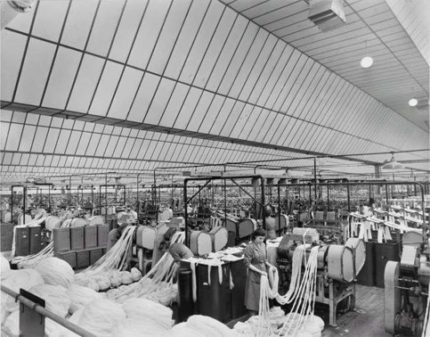Mowden House, a stately home up at Darlington’s “posh end”, will be well known to you if you have dealings with the Teachers’ Pension Service (TPS). It also used to be the home for a substantial Department for Education (DfE) presence and was the scene for an early trial on centralising assessment for student loan eligibility.
It’s almost forgotten now, but back in the mists of time the financial side of university attendance was managed by your local authority. Very much a postcode lottery, this led to undergraduates from similar backgrounds studying at the same university being offered vastly different support packages.
With the advent of the original national mortgage-style maintenance loans (now, of course, income-contingent loans), and the end of grants, the opportunity to centralise and standardise the offer – in new premises on the other side of town – was keenly taken. Peter Lauener, the interim Student Loans Company (SLC) CEO, tells the possibly apocryphal story that his organisation was originally set up and was to be run by a consortium of High Street banks. However, as the terms of the new loans became apparent banks got cold feet – ending with the last bank standing selling the fledgling company to DfE in exchange for a crisp £20 note proffered by a Permanent Secretary.
What can £20 get you?
If this is true (and Peter freely admits that the story may have been embellished as it has been retold) DfE and the devolved funding bodies – as shareholders – got quite a good deal for the price of a night out in Darlington.
It is, I hasten to add, entirely possible to have an excellent night out in Darlington. I grew up just down the road in Stockton-on-Tees – Darlington was the arty, bohemian alternative to the all-encompassing football culture of Middlesbrough and the legendary chip-shop “guacamole” terror of Hartlepool. I was a huge fan of the (sadly deceased) Arts Centre, where the alleged asking price of the SLC could get you two tickets to something endearingly odd plus four pints of Camerons Strongarm Bitter.
Darlo – as the locals know it – is now home to students, studying at the University of Teesside campus and the recently completed Darlington College, both on Vicarage Road. They face a town in transition – not long before my visit it became clear that two “anchor” shops in the town centre would be closing down.
So when I heard that most UK fee and maintenance loans flow through a former wool-processing factory in Darlington – on behalf of 8 million customers and nearly 800 institutions – I had to take a look. Lingfield Point is a sprawling business park colonising once derelict buildings close to the A66 trunk road to Teesside. SLC are an anchor tenant and, employing around 1,400 staff, one of Darlington’s biggest employers.

Lingfield point in its former life as a wool processing factory
The oak tree logo, familiar to graduates everywhere from those dreaded annual letters, is displayed at huge scale on the wall of a pale green building named Memphis. Inside, you immediately realise how seriously SLC take security and how proud they are of their home.
Serious data and serious process
The former is an entirely appropriate caution. SLC have access to some serious data – including a connection to the Passports Office that none of the senior staff I was with were allowed to see. As you’d expect, personal information arrives from applicants, institutions, the Department of Work and Pensions (DWP), and Her Majesty’s Revenue and Customs (HMRC), and there are strict controls over how this is used, digitised, shared, and managed.
Migrating from a system that relied on a huge mailroom and a lot of paper, the recent launch of e-signatures for agreement is just the first stage of a major redesign of processes and supporting software. Director of Operations Derek Ross explained how a partnership with Unipart has led to the adoption of lean methodologies to drive efficiency, and to an investment in an in-house development team that work alongside core staff to develop IT tools that support what needs to be done. I worried audibly about the effects on morale from all those metrics and targets but, from what I heard, staff had bought in to – and more importantly, taken ownership of – the practice
Day-to-day impact

Memphis House, the Darlington home of the SLC
Memphis House’s reclaimed industrial space is – as you would expect – lined with desks and workstations, but materials and designs have been chosen to reflect the building’s former life. Cheap, but modish furniture adds a utilitarian and pragmatic air – huge plants and images of nature and local history reflect the healthy, reflective, and diligent corporate culture. The welfare of staff is taken seriously and, again, measured frequently. It would almost be scary how systematised this is, if the staff were not so transparently on board with it.
Small, specialised teams are grouped around a huge open-plan area that broadly follows the application pathway on the right and deals with telephone and social media queries on the left. The other end of the organisational engagements with the outside world – their links and payments to institutions – is dealt with from three offices in Glasgow. And there is also an SLC centre at Llandudno Junction in Wales.
Banking domination
The SLC has a huge impact on UK banking systems – on two days of the year (the first Monday in January and the first Monday after Easter) it is the largest single user of the UK BACS system – making millions of payments to students and institutions. Interim CEO Peter Lauener notes that this is a distinction also held by his former employer, the ESFA, for other days of the year.
Lauener brings a great deal of knowledge to the interim role. He knows and speaks warmly of Philip Augar – the two worked closely together (and I imagine shared numerous happy conversations about banking at scale) during the latter’s time on the DfE board.
You’d think that these connections would lead to an influence in policy development, but – as with many sector agency bosses –Lauener is cagey about the extent of this. He did let slip that the SLC’s (excellent) analytics team has been contributing data and modelling to the DfE’s investigation of alternate funding models during the post-18 review. I think he’s rather understating the influence that this analysis will have on the future of the sector in England.
A sleeping giant
The growth of the SLC can be mapped by the volume of new responsibilities handed to it by the governments of the day. Starting off as a source of mortgage-style maintenance loans in 1990, income-contingent loans were added from 1998, then fee loans in 2003, with further changes made post-Browne in 2012.
The current system is both complex, and – when viewed as a UK-wide endeavour – rapidly diverging. SLC offers more than 400 discrete products, and administers highly specialised processes to deal with everything from EU applicants to – as recently hit the headlines – estranged students. It also manages advanced learner loans in the FE sector. In all, the loan books it manages stand at a jaw-dropping £120bn.
So why do we only hear about the SLC when something goes wrong? Recent concerns raised in Parliament about overpayments reflect the fact that the HMRC only provides salary data to the SLC annually. And although the latter urges graduates to switch to direct debit payments for their final year of payment to avoid the overrun, few do. So SLC and HMRC are now working on a joint project to share data monthly, which will begin flowing shortly. The stories over the summer around estranged students related to checks that the SLC is required to make. A new process could and should have worked better, but SLC staff worked hard to rectify problems and make amends.
No one can really be expected to love and care about their loan provider, but the SLC has tried to be as responsive as possible to the changing ways graduates wish to correspond. A social media team helps to respond to issues raised online and better web-based tools mean that the volume of calls to the vast call-centre operation have dropped from 4 million in 2013-14 to 2.6 million in 2017-18 (and these are, apparently, often made by parents rather than students). At peak times, eight applications are processed every minute. And on their busiest day last year (late September) the SLC fielded more than 30,000 calls.
If you’re thinking about UCAS here, you wouldn’t be the only one. Imagine UCAS with all the money. The SLC website will look just as familiar to prospective students – the application to both happens in the same academic year. Mistakes by both bodies – though staggeringly rare – can have huge consequences for individuals when they happen.
An ideal loan provider would be almost invisible. And for most, other than the monthly deductions and annual letters, it is. My thought on leaving Darlington station was whether it should also be invisible in the world of HE policy.
A new CEO, Paula Sussex, formerly of the Charity Commission, took the reins earlier this week. She’ll know something of the sector as her previous employer was the charities regulator for many student unions and some institutions. But with student finances once again a hot button issue, I have to admit to hoping that we hear more from the agency that is one of the first contacts students have with the HE system, and one of the most important contacts that institutions have.













Having been to Lingfield Point many times for SLC meetings, it’s really nice to see it profiled in Wonkhe. As you say, so much goes on there of vital importance to HE but it’s little known. If you’re planning a series I recommend going to Llandudno, which must have one of the most picturesque settings of any sector agency. Just on a point of accuracy – the SLC didn’t take over processing of student finance applications from local authorities in England until 2009, though it did pay out and collect loans from 1990 onwards as you say. And although there… Read more »